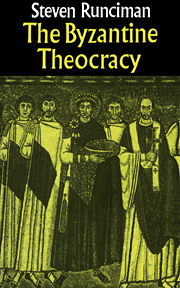Book contents
- Frontmatter
- Contents
- Foreword
- Introduction
- 1 The Christian Empire: The image of God upon earth
- 2 The Viceroy of God: The plenitude of Imperial power
- 3 The battle over images: The challenge of popular belief
- 4 The working compromise: The limits of Imperial control
- 5 The monks and the people: The opposition to the palace and the hierarchy
- 6 Decline and fall: The end of the Kingdom of God on earth
- Notes
- Index
2 - The Viceroy of God: The plenitude of Imperial power
- Frontmatter
- Contents
- Foreword
- Introduction
- 1 The Christian Empire: The image of God upon earth
- 2 The Viceroy of God: The plenitude of Imperial power
- 3 The battle over images: The challenge of popular belief
- 4 The working compromise: The limits of Imperial control
- 5 The monks and the people: The opposition to the palace and the hierarchy
- 6 Decline and fall: The end of the Kingdom of God on earth
- Notes
- Index
Summary
Constantine died, clad in stainless white, on 22 May 337. His dominion passed to his three sons, Constantius, Constantine II and Constans. They divided it between them, Constantine taking the Gauls, Britain and Spain, Constans Italy, Africa and Illyricum, and Constantius the whole of the East. The theory that one God in Heaven should be reflected by one Emperor on earth seemed thus to be abandoned: unless one took a Trinitarian view that they represented the Trinity. This hardly represented their own opinions, for they had been brought up with Arian, or, rather, Subordinationist, sympathies; and each wished his brothers to be subordinated to himself. But Constantine II was killed in 340, when fighting against Constans; and Constans was killed by an usurper, Maxentius, in 350. Maxentius was killed by Constantius in 353. Thenceforward, till he died in 361, with his cousin Julian in revolt against him, Constantius was master of the Empire.
Constantius has been unkindly treated by historians, partly because undue sympathy has been given to Julian, who hated him, and partly because he offended that great stalwart of Trinitarian Orthodoxy, Athanasius. In fact he was a competent and conscientious ruler, with mildly Arian sympathies, but tolerant and, like his father, anxious to force some acceptable compromise on the Church. His brother Constans, living in the West, came to accept Nicene theology and in 343 summoned a Council to Sardica (Sofia), which upheld the Nicene decrees but which was boycotted by the Eastern bishops. Constantius himself held a number of Councils, which were intended to conciliate the Arians and which were therefore regarded with deep disapproval by Athanasius.
- Type
- Chapter
- Information
- The Byzantine TheocracyThe Weil Lectures, Cincinatti, pp. 26 - 50Publisher: Cambridge University PressPrint publication year: 1977



